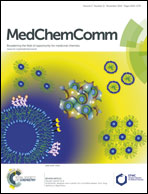Dehydroabietylamine derivatives as multifunctional agents for the treatment of Alzheimer's disease†
Abstract
Dehydroabietylamine derivatives have been reported to eliminate the superoxide anion (O2−˙) and 1,1-dipheny-2-picrylhydrazyl radicals. In this work, several dehydroabietylamine derivatives were shown to have potent anti-oxidative activity in SH-SY5Y cells and exhibited significant inhibition of Aβ42 self-mediated aggregation and the disaggregation of Aβ42 aging fibrils. In particular, the compound 12N,18N-bis(caffeoyl)-14-nitrodehydroabietylamine (3b) showed the most potent inhibitory activity against Aβ42 self-mediated aggregation with an IC50 value of 3.96 ± 0.33 μM. Compound 3b decreased the production of Aβ42 in swAPP HEK293 cells and showed neuroprotective activity against Aβ42-induced cytotoxicity. Through reducing the production of the Aβ42 species, compound 3b alleviated Aβ42-induced paralysis in transgenic Caenorhabditis elegans strain CL4176. Considering its multifunctional activity and low cytotoxicity, 3b is considered to be a potential multifunctional agent for the treatment of Alzheimer's disease.


 Please wait while we load your content...
Please wait while we load your content...